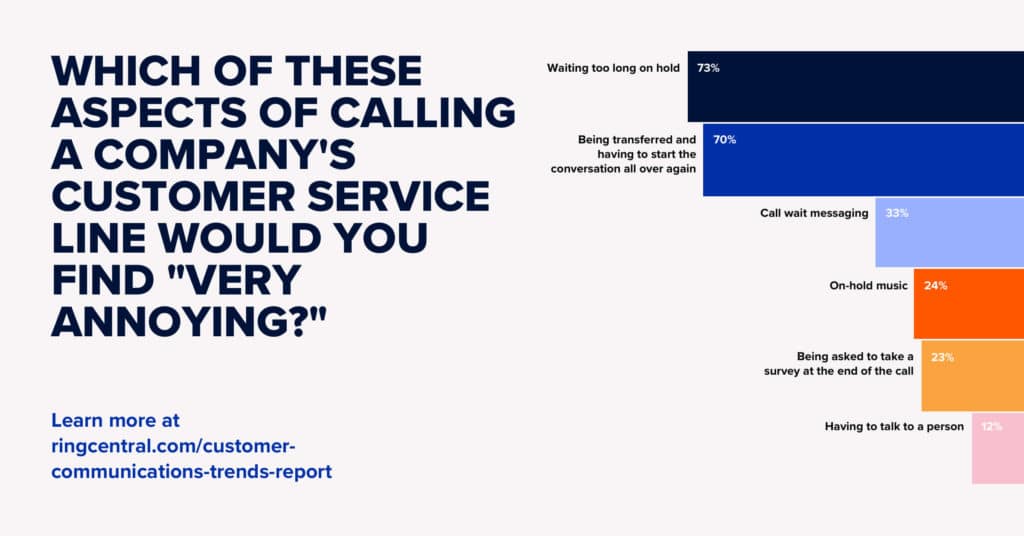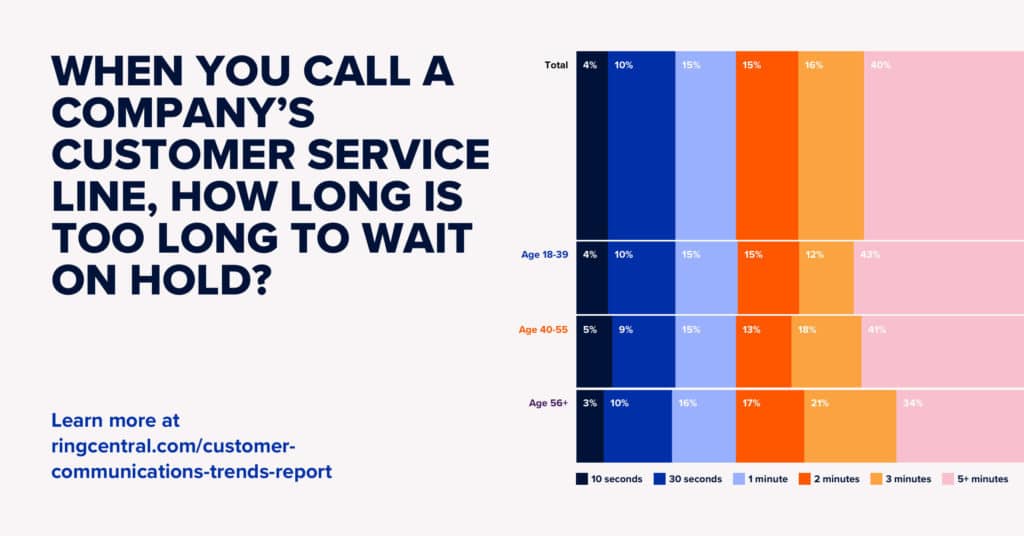Who likes having angry/upset/disappointed customers? Realistically, nobody. But no matter how well-run your business is, you’re going to encounter them at some point.
And customer complaints are important. They’re opportunities to improve your business and turn dissatisfied customers into loyal ones. Brushing them off or ignoring them just creates more problems down the road.
We’ll admit, it can be hard to keep that positive mindset at times. Especially when you’re dealing with a very negative individual. But having good training and a good strategy can make all the difference. It just takes a little preparation.
When we created our contact center product, one of our main goals was to help businesses communicate with their customers and respond to their feedback—and customer complaints are an inescapable part of feedback.
Don’t be afraid of them. Embrace them, learn from them, and grow. In this post, we’ll cover:
- Tips for handling customer complaints
- The most common customer complaints and how to address them
- 3 examples of customer complaints—and how companies handled them
How customer-obsessed is your business? Take the quiz. 💚
Tips for handling customer complaints
Before we get into the nitty-gritty, we should talk about the basics. There are some majors dos-and-don’ts when it comes to handling complaints, no matter the topic. You should keep these in mind whenever you’re dealing with a customer complaint.
- Don’t question their claim
How do you make an angry customer even more angry? By casting doubt on what they’re telling you.
This may seem painfully obvious. But when you’re deeply involved with your business, it becomes easy to get defensive. It’s also unpleasant to hear your colleagues or service being criticized.
But let them talk and ask questions to make sure you understand the problem, instead of trying to defend your company or rationalize why they had a bad experience.
[ebook-download title=”How customer-obsessed is your business?” link=”https://netstorage.ringcentral.com/documents/quiz_how_customer_obsessed_your_business.pdf” cta-text=”Take the quiz” src=””]
- Don’t take it personally
Angry. Sorrowful. Exasperated. Insulting. Customers with complaints may, unfortunately, fall into any of these buckets.
But even when a customer is being rude or snapping at you, it’s important to remember that it’s not you they’re angry with. They’re angry because they’ve had a bad experience. And you’re an outlet for those negative emotions.
Which is still, of course, not great. But taking it personally won’t accomplish anything except making your day worse. Stay calm, log the details of the complaint in your customer service software, and then…
- Empathize
These customers are contacting you because they have a grievance. So let them know that you hear them, that you’re sorry for what they’ve experienced, and that you want to help.
Empathy is an extremely important factor in helping unhappy customers. Putting yourself in their shoes will enable you to better understand their side of things—and at the same time, it’ll help calm them down if they’re being over the top.
- Attempt to resolve the problem to the best of your ability, or escalate it to someone who can
We’ll take a deeper look at examples of this in the next section. But don’t end your interaction with them before you’ve either solved their problem, or you’ve done everything you could and passed it on to the next best person.
Otherwise, you’ll create an even angrier customer, who will feel like your incompetence has wasted even more of their time.
In these cases, make sure that you have your customer’s past conversations recorded so that anyone on your team can easily pick up the conversation where it was last left off. After all, being transferred back and forth and having to repeat themselves is one of the biggest complaints from customers when calling a company:
- Ask if there’s anything else they need, and show gratitude
Ask if they have any other questions or concerns besides what you’ve already discussed. This shows them that you’re not just trying to churn through callers as fast as you can.
And finally, thank them for contacting you and sharing their problem. Gratitude is never overrated.
What are the most common customer complaints?
Why do customers complain? The list could go on forever. But most call center staff know that complaints usually follow specific patterns, even across industries.
We’ve put together some of the more common reasons that customers complain, as well as ways to address them. We hope this helps you prepare for when the worst happens.
Product or service complaint
This one is the type of complaint that any type of business in any part of the world will get at some point.
Keeping our tips from above in mind, listen to them and collect as much information as possible. This is a chance for you to improve on whatever the problem is, and chances are, this person isn’t the only one having this issue.
(Not sure how to effectively implement customer feedback? We’ve got you covered on that topic here.)
Then, once you have everything recorded, it’s time to win them back. Depending on the product or service, you could offer a replacement or a discount on future purchases. Just show them that you care about their experience with you and you’d like a chance to do better next time.
They’ve spent too much time on the phone
There are a few different reasons why this might happen.
First of all, maybe they’ve just been waiting too long to speak with somebody. According to the Customer Communications Review, 60% of respondents said that three minutes was the maximum acceptable time on hold when calling a company:
The ones who stick around will do because they feel they have a legitimate reason to do so, but it won’t make them any happier.
And, possibly even worse, there’s the ones who have already spoken with people but haven’t had their problem solved. And then, worse again, they’ve had to explain themselves a second, third, or (may the universe have mercy) fourth time.
Long wait times suck, but sometimes they’re hard to avoid. Multiple explanations, though—there’s never an excuse for that.
Solutions like RingCentral Contact Center™ can help you address both of these issues. Contact Center uses intelligent call routing software to help callers get in contact with the best agent to serve their needs:
Automated IVR can also sometimes answer customer questions without the need for human intervention, freeing up your staff for the more complicated questions. Automated call-backs also help customers go about their day without their phones glued to their ears.
And to avoid the incredibly frustrating repeated explanation, Contact Center also helps support agents build profiles of their customers and pass on information to colleagues if they can’t solve the issue directly. It’s a much more efficient use of everybody’s time.
No follow-up
Customers with unsolved issues are the worst for your business—they can be vocal about their dissatisfaction, and that dissatisfaction will only fester and spread if it’s left unaddressed.
So make sure that you and your staff follow up on customer complaints. If you’ve promised a customer that you’ll escalate their problem, keep them updated about its status. Try to give a clear and transparent timeframe.
3 examples of customer complaints
What’s an article about customer complaints without some entertaining examples?
Here you go—three companies that addressed their complaints in different ways. All of these offer good examples of how to treat your customers.
Virgin Airlines
Airlines aren’t exactly known for their food. It’s possibly the most ridiculed cuisine in the world, and definitely one of the most common stand up comedy topics.
But one customer, flying with the U.K’s Virgin Airlines, took their dissatisfaction to another level by writing a tongue-in-cheek letter to the airline’s founder, Richard Branson, as well as posting it online.
You can read the full letter here1, and we encourage you to, because it’s absolutely hilarious. Here are a few snippets:
“By the end of the flight I would have gladly paid over a thousand rupees for a single biscuit following the culinary journey of hell I was subjected to at the hands of your corporation.”
“I needed a sugar hit. Luckily there was a small cookie provided. It had caught my eye earlier due to its baffling presentation:
It appears to be in an evidence bag from the scene of a crime. A CRIME AGAINST BLOODY COOKING.”
Richard Branson responded to the hilarious letter by apologizing and inviting the customer to join Virgin Airlines’ tasting panel.
This was a great and thoughtful way to turn an online embarrassment into a victory. Inviting a customer to be part of the solution is a great idea for any business looking to change tracks on a mistake.
Innocent
British smoothie company Innocent is known for their whimsical packaging and their delicious juices. But something must have gone wrong with their machinery because one customer found half a banana in their bottle.
Innocent responded to this by posting an open letter on their site2. They offer a couple of reasons as to how the banana slipped past their procedures, such as a faulty blender, or a rogue chimpanzee. But they also ended the letter with an apology and a reassurance that nobody else would find an entire piece of fruit in their smoothie.
Blending an apology with self-deprecating humor is a good approach to take, as it shows customers that you’re not above owning up to your mistake and even laughing at yourself. Also, it’s lucky that the customer didn’t choke on the banana, or it could have been a whole different story.
Skyscanner
Another airline-related example, except this time, it’s with Skyscanner, a booking service.
Skyscanner attempts to find customers the cheapest route to their destination in the best amount of time. But their algorithm must have had a glitch, because one customer found that they’d been advised to purchase flights with a 47-year layover in between.
This complaint was made on Facebook, and Skyscanner’s social media staff took a moment to respond humorously:

As we mentioned above, when done tastefully, humor can be a good smoothing-over tactic. Just make sure to address the problem as well, as Jen did when she said she’d get her folks to look into it.
Don’t be afraid of customer complaints
If you’re running a small business, then believe it or not, you might be luckier than big corporations when it comes to customer complaints.
First of all, you’re much less of a huge faceless entity, so when you empathize with customers, they might find it more believable. Second, you’re not tied up in bureaucracy as so many big companies are. You have the opportunity to build your customer complaint process from the ground up, figuring out what works and what doesn’t, instead of slogging through overblown policies and processes.
And make sure you have the right tools to deal with complaints, too. Solutions like RingCentral Contact Center will empower you and your staff to manage customers and their complaints, effectively minimizing the negative feelings.
Keep empathizing, keep listening, and keep improving!
1 dearcustomerrelations.com/best-ever-complaint-letters/virgin-atlantic-in-flight-food
2 innocentdrinks.co.uk/blog/2015/february/we-all-make-mistakes
Originally published Jul 01, 2020, updated Nov 02, 2020







